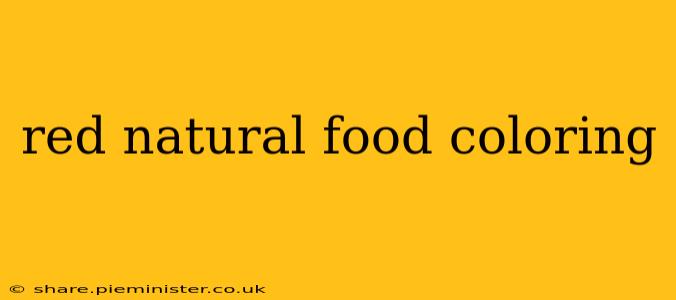Adding a splash of red to your culinary creations can transform a dish from ordinary to extraordinary. But achieving that vibrant red hue naturally, without resorting to artificial dyes, can be a challenge. This comprehensive guide explores the world of red natural food coloring, examining various sources, their properties, and how best to utilize them. We'll also tackle some frequently asked questions to ensure you're well-equipped to bring the natural vibrancy of red to your cooking and baking.
What are the Best Natural Red Food Colorings?
Several natural ingredients offer beautiful red hues, each with its own unique characteristics. The intensity and shade of red can vary depending on the source, preparation method, and even the ripeness of the ingredient. Some of the most popular options include:
-
Beets: A readily available and versatile option, beets offer a deep, earthy red color. Their intense pigment makes them ideal for adding color to sauces, jams, and even cakes. The color can be intensified by cooking the beets before extracting the juice or puree.
-
Cherries: Tart cherries, especially, provide a brilliant, almost crimson red. Pureed cherries can add both color and flavor to desserts, drinks, and glazes.
-
Raspberries: These berries offer a lighter, slightly more pinkish-red color. Their delicate flavor complements many desserts and drinks. The color is best extracted by pureeing or blending the raspberries.
-
Cranberries: Cranberries provide a deep, ruby red hue. Their tartness complements many dishes, and they're especially suitable for sauces, jellies, and breads.
-
Red Cabbage: While not traditionally associated with red food coloring, red cabbage, when treated with an acidic liquid (like lemon juice or vinegar), reveals a stunning reddish-purple hue. This reaction changes the pH and creates anthocyanins that offer beautiful color.
-
Paprika: Paprika, especially the smoked varieties, can contribute a rich, reddish-orange color. It’s a great option for adding color and a subtle smoky flavor to sauces, rubs, and spice blends.
How Do I Make Natural Red Food Coloring at Home?
Creating your own natural red food coloring is surprisingly easy. Generally, it involves extracting the pigment from the chosen ingredient. Here’s a simple method:
- Prepare the ingredient: Wash and thoroughly clean your chosen red ingredient (beets, cherries, raspberries, etc.).
- Cook (optional): For some ingredients, cooking intensifies the color. Boil beets until tender, for example.
- Blend or puree: Use a blender or food processor to create a smooth puree.
- Strain (optional): For a clearer color, strain the puree through a fine-mesh sieve to remove solids. This step is particularly helpful with ingredients like raspberries.
- Reduce (optional): For a more concentrated color, gently simmer the puree or juice until it reduces, concentrating the pigment.
Remember to adjust the amount of natural coloring used based on the desired intensity of color and the recipe.
How Stable is Natural Red Food Coloring?
The stability of natural red food coloring can vary depending on the source and processing. Some natural colors are more susceptible to fading or discoloration when exposed to light, heat, or air. To maximize stability:
- Store properly: Store your natural food coloring in airtight containers in a cool, dark place.
- Add an antioxidant: Adding a small amount of lemon juice or another antioxidant can help preserve the color.
- Use promptly: For best results, use freshly prepared natural food coloring whenever possible.
Does Natural Red Food Coloring Stain?
Yes, many natural red food colorings can stain. Beets, cherries, and cranberries are particularly notorious for staining. Use caution when handling these ingredients and consider wearing gloves to protect your hands. Be mindful when working with light-colored surfaces, fabrics, and utensils.
What are the Differences Between Natural and Artificial Red Food Coloring?
The primary difference lies in the source. Natural food colorings are derived from plants and other natural sources, while artificial colors are synthetically produced. Natural colors tend to be more susceptible to fading and may impart subtle flavor nuances, whereas artificial colors are usually more stable and have a neutral taste. Many people choose natural colors for health or ethical reasons, preferring to avoid synthetic additives.
Is Natural Red Food Coloring Safe for Consumption?
Generally, natural red food colorings derived from commonly consumed fruits and vegetables are considered safe for consumption. However, always ensure the ingredients are fresh and properly prepared. Individuals with specific allergies should exercise caution and check ingredient lists carefully.
This guide provides a foundational understanding of natural red food coloring. Experiment with different ingredients and techniques to discover the perfect red hue for your culinary masterpieces. Remember to always prioritize food safety and enjoy the vibrant results of nature's palette!
